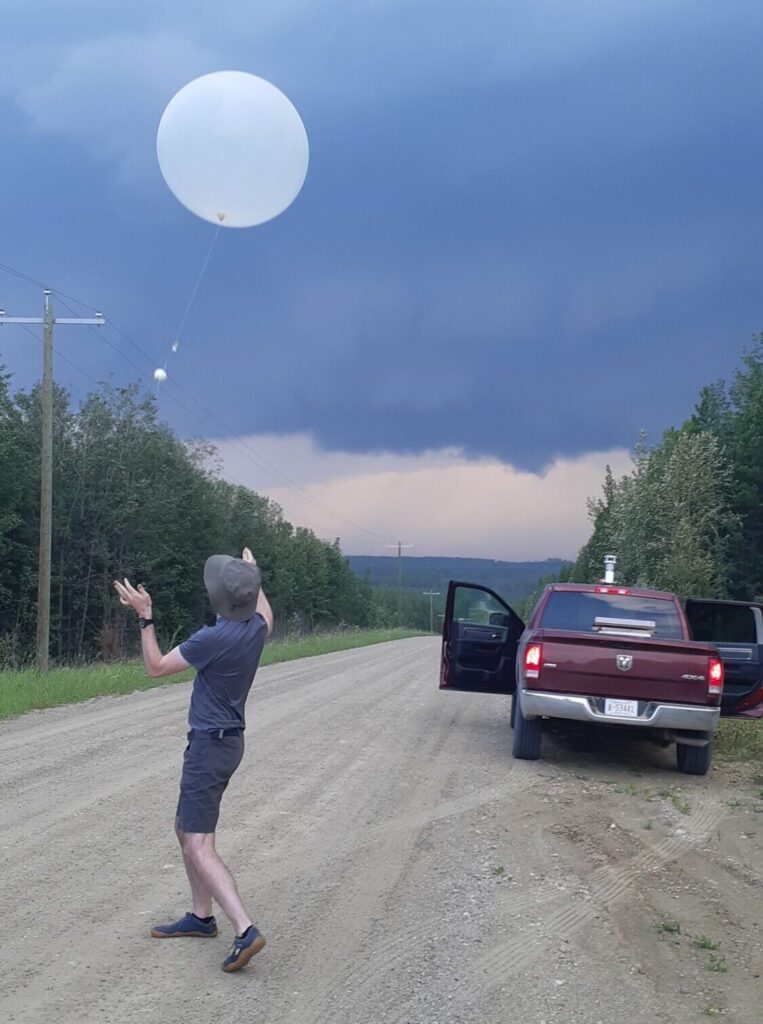A red Jeep skids nearby a menacing tornado. Moments later, a science team hops out with a bunch of flying sensors they hope to inject inside. They then speed off to shelter to await the results.

It’s the plot of the 1996 Hollywood hit Twister, but – if you take out the airborne cows from the movie’s most famous scene – it’s also real life. On July 24, two “hailsonde” sensors successfully sailed into a hailstorm near Edmonton courtesy of a movie-like collaboration between the Northern Hail Project (NHP), and Australia’s bureau of meteorology. NHP is a research spinoff from Western University’s Northern Tornadoes Project,
Inspiration came from the “Dorothy” system featured in Twister, which was a garbage-sized can full of round sensors for tornado sensing. In fact, just about every thunderstorm-studying scientist has seen Twister, participating Australian scientist Joshua Soderholm told SpaceQ.
“It’s still considered the best storm-chasing movie of all time, and a real inspiration for the current generation of young and mid career scientists,” he wrote in an e-mail. (Twister star Bill Paxton also co-starred in 1995’s Apollo 13, based on the NASA astronaut mission to the moon.)
The hailsondes, Soderholm added, are like the Dorothy sensors in many ways: “They are a similar size [and] shape and both transmit data in real time. I’m still waiting for the tornado research community to develop similar probes for studying tornadoes.”
The hailsondes rode along in Western’s NHP campaign in 2023. They are repackaged windsonds (weather balloon systems) made by Swedish atmospheric measurement solutions company Sparv Embedded, which uses a durable spherical shell held together with 3D-printed parts.
Inside each hailsonde is a device measuring pressure, GPS location, and outside metrics including temperature and humidity. All information flows back to a receiver, connected to a laptop. But instead of using a metallic can to fly like in Twister, the hailsondes were hefted into the storm via weather balloon.
Participants in the tech design included Soderholm, Matthew Kumjian from Pennsylvania State University, Ph.D. student Jordan Brook at the University of Queensland, and Anders Petersson from Sparv Embedded.
“Once the probe encounters a strong updraft – air moving upwards into the storm – the probe can itself cut the tether to the balloon, allowing the probe to continue to rise in the updraft just like a real hailstone,” Soderholm said. But only eight hailsondes can operate at the same time given receiver limitations: “It’s not quite the hundreds of probes Hollywood dreamed up for Twister,” he said.
Hailsondes also provide direct measurements of the conditions under which hailstones form, providing a valuable supplement to Earth observations of storms by satellites. Their measurements will be compared against simulations modeling hailstone pathways, which are themselves derived from weather prediction models or remotely sensed information from weather radar.

“The weather radar approach also has a practical application: it can be used to accurate predict the hail swath from current hailstorms,” he said. “This accuracy is far greater than conventional methods, because the full pathway of hailstones is considered. Weather radars have limited coverage, and going forward into the future I’d be excited to apply this technique using information collected from space platforms – which give continental-scale coverage.”
The balloons only need to last a few minutes, long enough to get caught into the updraft and for the tether to be cut. As for the hailsondes, they can last roughly an hour on their batteries – about four times as long as the 15 minutes a typical hailstone takes to launch and land.
“Our biggest challenge was making sure the hailsondes survive the extreme icing conditions and likely collisions with other hailstones,” Soderholm said. “Many tests were performed to simulate these conditions, and many design revisions as a result.”
The other challenge was finding the right storm. Weather radar data and typical stormchasing skills both came into play, especially including safety considerations. For example, the team always has an escape route – a north-south road if possible – and well-practiced procedures to get a balloon pre-inflated in the car and out the door in minutes. They retreat to a safe distance kilometers away, wait for the storm to pass through and then go back to collect and measure the hailsondes.
“Our first major finding was that the hailsondes work, and better than expected,” Soderholm said. “They not only survived the extreme conditions inside supercells, including becoming coated in ice, but managed to send data through a full trajectory from launch to landing.”
The two successfully retrieved hailsondes suggest they converged inside a single supercell, even though they were launched four minutes apart from each other. They also landed quite close to each other. “The data will need to be further analyzed and compared to simulations of hail in supercells to determine if the models look similar – or very different – to these new observations,” he added.
Other probes were lost because they fell into a forested area not accessible to the researchers, who do try to recover every hailsonde where they can. “The hailsonde materials are not biodegradable, but the small size and mass – compared to traditional radiosondes – means there’s less pollution,” Soderholm said.
The hailsondes may also provide insight into mesocycles, a key process in supercell storms that generate most of the severe weather in thunderstorms. To learn more, the hailsondes’ development will be formalized and published in the near future, he said. A campaign is already underway to use them again in Europe and Canada in 2024 and the United States in 2025-6.
While the research publication is still underway, the hailsondes do have a notable community win already. The technology was a finalist for the 2022 Harry Otten Prize for Innovation in Meteorology, presented by the European Meteorological Society every two years for innovations that can be deployed rapidly with community benefits.
 SpaceQ Space news and analysis.
SpaceQ Space news and analysis.



